Have you ever stood on the beach, gazing out at the endless sea, and felt the excitement of the crashing waves? If so, you’re in for a treat. Surf fishing may seem challenging with its vast waters, hefty gear, and those mighty saltwater creatures, but don’t fret! In this beginner’s guide, I’ll walk you through everything you need to show you to kick-start your surf fishing journey. We’ll chat about picking the perfect rod and reel, understanding types of bait and rigs, and scouting out that prime spot on the shoreline. I’m here to share what I’ve learned so that you can approach surf fishing with confidence, and before you know it, you’ll be casting like a seasoned angler. So, let’s get started on this exciting adventure together!
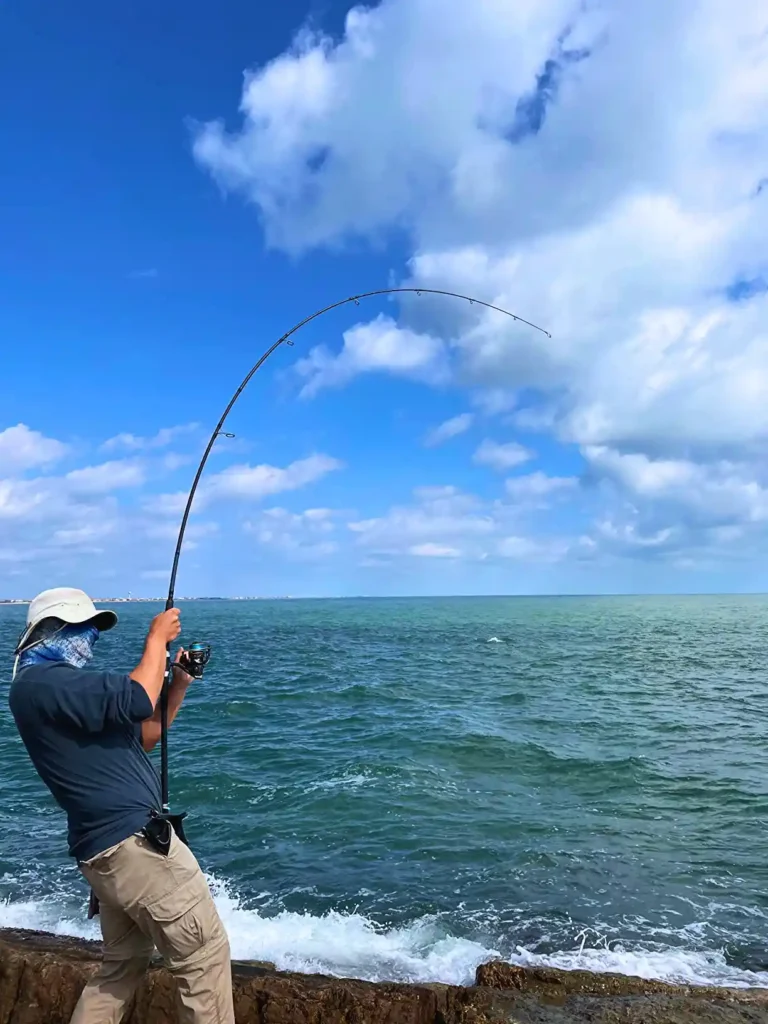
WHAT EQUIPMENT AND GEAR ARE ESSENTIAL FOR SURF FISHING?
Surf fishing essentials:
- Sand spikes and Rubber wallet
- Fishing rods and reels
- Bait options;
- Bait
- Cut bait
- Frozen bait
- Lures
- Spare line, hooks, and tackle
- Bait bucket with aerator
- Surf fishing rigs
- Sharp knife
- Pliers
- Wet towel
- First aid kit
- Sunscreen, hat, and sunglasses
- Raincoat and wind jacket
- Waders, neoprene socks, jacket [cold days]
- Valid fishing license
The great thing about surf fishing is its simplicity. You don’t require expensive gear or such expensive preparation, which is why anglers love it.
SURF FISHING GEAR DETAIL:
Surf fishing requires more substantial equipment than freshwater fishing. For effective surf fishing, an enormous length rod and reel promises you to cast your bait further and handle more prominent, more substantial fish.
BEGINNER SURF FISHING ROD SETUP: It’s advisable to start with a combo that includes a surf rod between 8 to 9 ft. in length. This rod length helps you cast farther into the ocean waves. ALONG WITH THE ROD, YOU SHOULD USE A REEL IN THE 6000 TO 8000 SERIES RANGE. THESE REELS ARE CAPABLE OF HOLDING THE NECESSARY AMOUNT OF FISHING LINE AND PROVIDE THE STRENGTH NEEDED TO BATTLE LARGER FISH.
WHEN IT COMES TO FISHING LINE, IT IS RECOMMENDED TO USE BRAIDED LINE WITH A STRENGTH RANGING FROM 25 TO 50 POUNDS. THIS STURDY LINE CAN WITHSTAND THE CHALLENGES OF SURF FISHING, AND YOU MIGHT ENCOUNTER POWERFUL FISH AND ROUGH CONDITIONS.
SURF FISHING ROD
Surf fishing rods are longer than other fishing rods, varying from 7 to 15 ft., and help to cast heavy bait to reach fish in the surf. The primary reason for their considerable size is to provide the necessary height and power to cast your line beyond the breaking waves near the shore.
A surf fishing rod of 8 ft. is ideal when dealing with calm water. However, going for a ten-foot-long rod is recommended if you’re dealing with more turbulent water. As you know, this extra length helps you to reach the fish.
Additionally, surf fishing rods have two more supporting characteristics: power and action.
Power signifies the rod’s strength, while action describes its degree of flexibility. Power and action combined play a vital role in the rod’s performance. Here, you can check more about fishing rod power and action.
WHAT LENGTH ROD FOR SURF FISHING?
In the case of surf fishing, if you are a beginner, you should keep two different setups. A more extended rod setup (12 to 13 ft.) is for holding more weight, targeting larger species, and casting longer distances, and a shorter rod setup (8 to 10 ft.) is for having smaller weights and targeting smaller fish.
But, if you want versatility using one surf fishing rod, we suggest you use medium heavy rating (8 to 12′) and medium action. This combo works well when casting heaving sinkers and to handle fish species whose lengths are over 3 feet.
SURF FISHING REEL:
The spinning reel is the most common and easiest reel for surf fishing. The popular reason is that they are easy to handle and can pair with short-length rods.
However, these reels are ideal if targeted species are more extensive and want more power and strength to fight.
WHAT REEL SIZE FOR SURF FISHING?
For surf fishing, the reel size should match the rod size. In the case of two setups, the reel size 1000 to 3000 is perfect for shorter-length rods. For longer-length rods, a reel size of 4000 to 6000 is needed for targeting bigger prey and casting longer distances.
Typically, a reel size of 6000 to 8000 is commonly used for tackling even bigger fish species like snook, sharks, bluefish, and redfish.
These more giant species fight back and run in their defense; you should have enough lines of up to 500 yards on your reel. This is where big reels come into play.
SURF FISHING LINE:
Two types of fishing lines are available, monofilament and braided, and the choice between them depends on fishing conditions and targeting species, etc. Anglers often choose the type of line ideal for their circumstances, and there is no one-size-fits-all answer. Each comes with advantages. Let’s discuss each.
Monofilament lines:
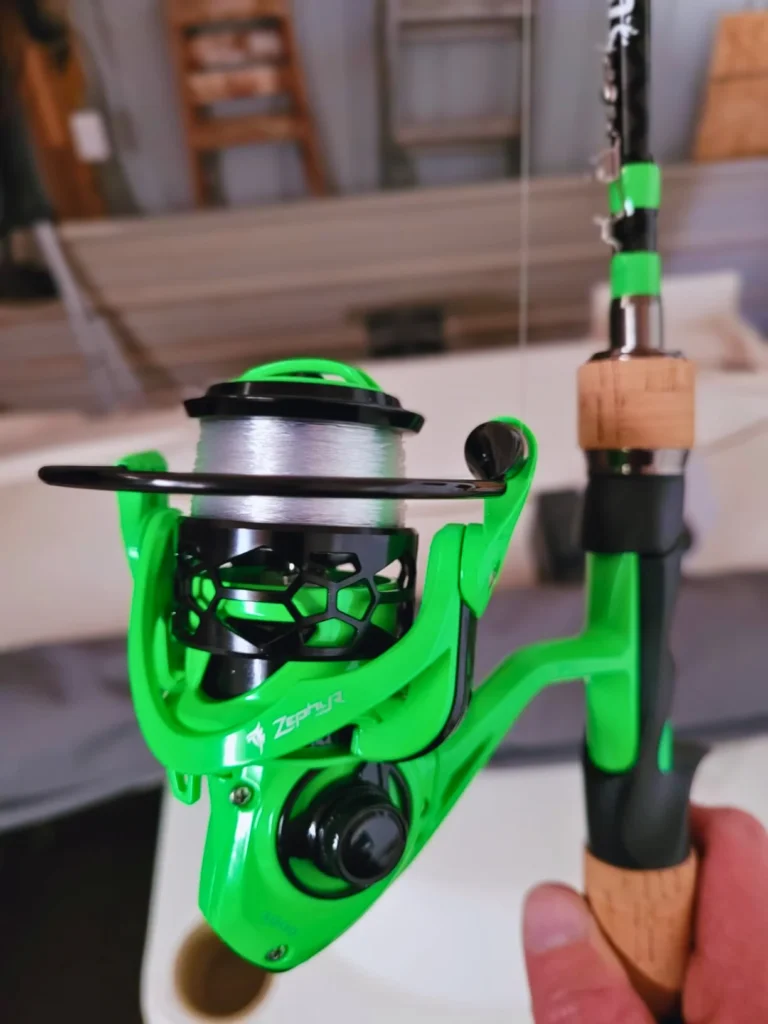
The lines are harsh and less likely to snap, which is crucial when dealing with fish with sharp teeth. These lines are more flexible as compared to braided lines.
Braided lines:
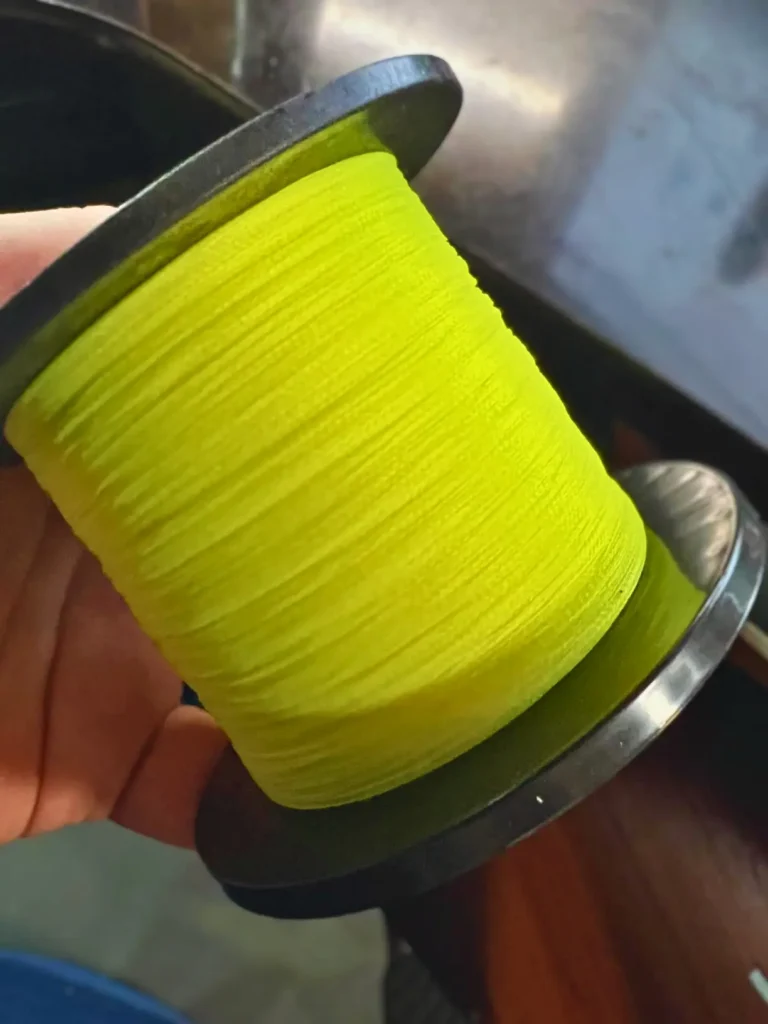
Braided lines are much thinner than monofilament, making them harder for fish to see in the water. As a result, fish become less conspicuous. However, the braid is lighter, so it allows longer casting distances.
Tip 1: Because the braided line is thin and becomes slick when wet, it’s essential to tie very secure knots to prevent them from slipping.
Tip 2: Fill Your Reel Adequately, it’s crucial to ensure that you have enough lines on your reel. If your reel can hold 500 yards of 25 lbs. Braided line, make sure you spool it with approximately that amount.
WHAT SIZE LINE FOR SURF FISHING?
For monofilament lines, we recommend using 5 to 10 lbs. for smaller setups. When it comes to medium-sized reels, you should opt for 15 lbs. while 15 to 30 lbs. lines for massive reels and long rods.
As a braided line, we recommend sizes up to 30 lbs. for small and medium reels, while 50 lbs. is perfect for larger setups.
Monofilaments or braided lines, which one is better?
For beginners, monofilament lines are recommended not only because of their affordability but also because they are easy to use and have several strengths. In contrast, braided lines are used at advanced levels for accuracy and longer casting distances. Out of both, braided lines encounter less wind and water current resistance, allowing you to control your bait better in solid surf conditions.
WHAT SIZE BRAID FOR SURF FISHING?
A 30 lbs. braided line should suffice for smaller and medium reels. If you’re going after larger species, consider using up to 50 lbs. braided line.
TERMINAL TACKLE
Leader:
Operating a leader is essential when you surf casting, especially if you’re going after fish with sharp teeth or fishing near structures and rocks.
Think of a leader as a strong protector of your line. For larger fish, like the toothy ones, you’ll want a steel leader that can handle 30 to 100 pounds of force, depending on the type of fish you’re targeting. Using a shock leader is also a smart move.
This extra-strong line reduces the risk of your line snapping and losing your fishing gear. Plus, it makes your line easier to handle in challenging surf conditions. So, leaders are like your fishing insurance, keeping those big catches connected to your line.
Sinker:
Sinkers, also called weights, are crucial gear for your fishing setup. There are many sinker types, like egg, bullet, slip, teardrop, pyramid, or Sputnik sinkers. Which one you pick depends on how the water is moving and the kind of seabed you’re dealing with.
Most folks go with 3-ounce pyramid sinkers for sandy bottoms – they’re a top choice. The weight of your sinkers can range from 1 to 8 ounces. If you’re aiming for bigger fish or the ocean’s currents are strong, you’ll want the heavier ones to keep your bait down where the fish are hanging out.
Hooks:
Hooks range from sizes 1/0 to 8/0. The trick is to match the hook size to your bait’s size, which, in turn, depends on the fish you aim to catch.
You’ve got options like circle hooks, J-hooks, and wide-gap hooks, all of which can do the job effectively. So, think of hooks as the finishing touch to your fishing setup, and having different sizes on hand will give you versatility in tackling various fish species.
SURF FISHING BAITS:
Live bait:
Live bait has always been a good option during surf fishing. You can buy frozen bait, considered the most convenient possibility for anglers readily available, such as squid, shrimp, mullet, and bunker.
Cut bait:
When targeting sharks and flounder during your fishing trip, using cut bait like squid strips, mullet strips, and shrimp can be highly effective. These baits are known to attract these specific types of fish. Additionally, you can consider using sand crab, clam, greenbacks, and sandworms as alternative bait options, as they also work well for enticing various fish species.
Artificial bait or surf fishing LURES:
Indeed, anglers prefer live bait, but artificial lures can be handy in a pinch. If you don’t want the hassle of keeping live bait with you, you have options like soft plastic baits, spoons, jigs, and top water poppers.
Soft plastic baits are helpful because they emit a strong aroma that attracts your fish. For precision and hands-on fishing, jigging around underwater is the perfect approach.
These lures appeal to fish through their visual appearance, so use them when water is clear, and surf conditions are medium that allows the fish to see them.
SURF FISHING RIGS:
There are different types of rigs with each specification.
Fish-finder rig:
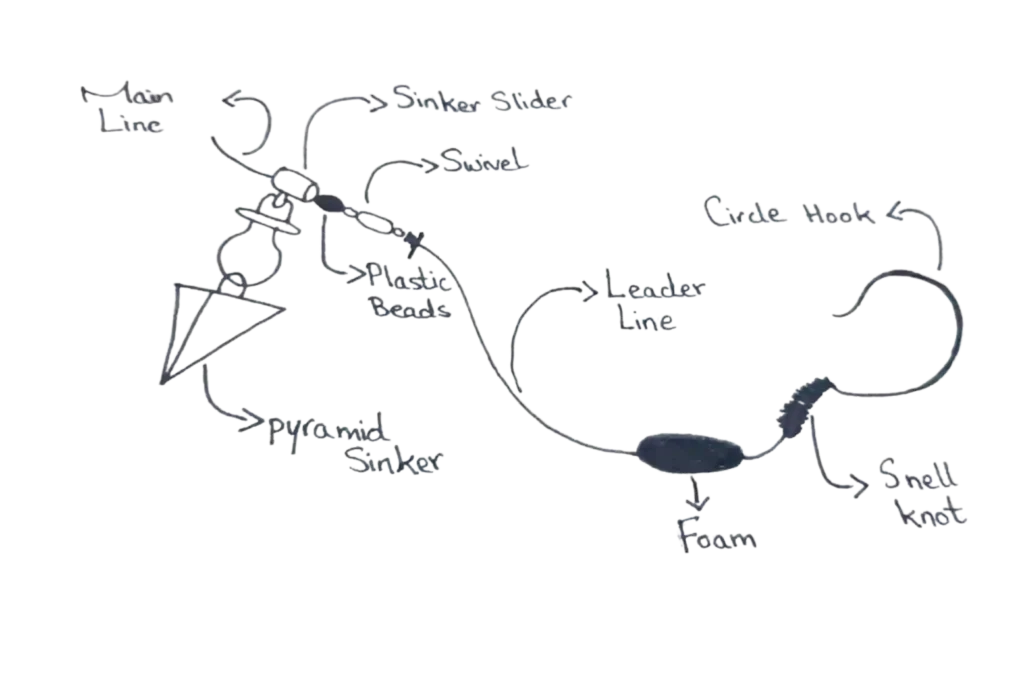
A simple fishing setup, the fish-finder rig or sliding, can be used in various conditions to target different species like striped bass, sharks, and big red drums over 3 ft. A fish-finder rig is excellent for frozen bait like mullet, bunker, or shad.
To set up this rig, you’ll need a few essential components:
- Sinker with swivel: start by attaching a pyramid sinker to your fishing line with a swivel. This helps you to reach the depth. You can use 3 to 4 oz. Weight. Pyramid-shaped or egg-shaped sinkers both work well for fish finder rig setups.
- Leader line: generally, the leader line is about two feet, but you can adjust the line according to your needs. For targeting larger species like sharks, the leader line should be 3 to 4 ft., Whereas shorter leader lines work well for short casting distances.
- Bead: The bead is used to prevent the knot attached to the leader line of the main line and with the sinker slide. The bead also keeps the sinker in place.
- Circle hook: at the end of the leader line, tie on a circle hook. This hook is suitable for various bait types and helps hook fish securely.
- Bait: use cut or frozen bait of your choice, depending on the target species. Go for substantial pieces of cut bait for larger fish like sharks, striped bass, or big red drum (over 3 feet).
- Foam float: to keep your bait away from these pesky bottom feeders, insert a 2-inch foam float onto your leader line a few inches above the hook. This float suspends your bait above the seabed, making it less accessible to the smaller creatures.
It’s a leader with a hook connected to your main fishing line with a strong swivel. There’s also a particular sinker slide involved. This rig is handy when you’re using big pieces of bait because it lets a fish grab onto the bait before you hook it. You can catch all sorts of fish with this rig, from fluke to brown sharks. Just remember to change your hook size, leader length, and leader strength depending on the kind of fish you want to catch.
If your leader (the line with the hook) is too long, casting can be more complex because it catches more wind. When you’re fishing for striped bass using bait, you need to use circle hooks.
High-low rig:
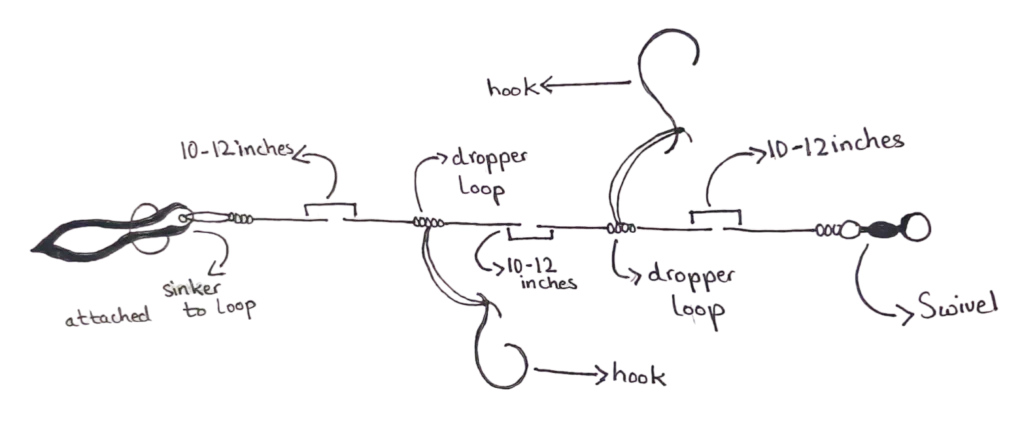
Anglers use this setup to increase the chances of catching the fish because the setup offers two hook baits on a single rig. In a high-low rig, the hooks are spaced above the weight.
One of the most essential facts of this rig is that it allows you to present two baits simultaneously. At the same time, the downside is that the weight is fixed in place.
Anglers use high-low rigs to quickly set the hook because fish drop the bait when they feel insecure. This rig is more effective with more minor, softer baits like worms or clams.
There are some other well-liked surf fishing setups you might want to know about. Pompano rigs are handy if you’re aiming for smaller fish. Fireball rigs are your go-to choice when using live bait. And if you’re new to surf fishing or fishing with kids, ready rigs are a fantastic option. These different rigs cater to various fishing situations and preferences, offering you flexibility when you’re out by the shore.
BEST SURF FISHING ROD SETUP:
As mentioned earlier, it’s recommended to have two surf fishing rods. The rods enhance your fishing experience by allowing you to target more different species. You can quickly take the specific rod out according to need.
Your one surf fishing rod setup should have a heavier rig used for cut bait, while the other should have a smaller rig used for squid and shrimp.
The heavier rig targets larger species, while smaller rigs are used for smaller species.
SURF FISHING STRATEGY:
When it’s time to cast, walk into the water to maximize how far your bait goes. After you cast, let your bait sink all the way to the bottom. If solid waves or currents push your bait back to shore, add more weight until it stays put.
When your bait reaches the bottom, and you don’t feel any movement, it’s time to step back with the bail (the little flipper thing on your reel) open.
Gradually, start slipping the line from your fingers, holding it tightly to avoid tangling due to waves. Close your bail and place the rod in a sand spike. It’s a holder for your fishing rod in the sand.
Now, slowly reel in the fishing line for tightening to make the rod bend.
Wait for a while until the aroma of bait attracts a heavier fish.
At this moment, you should be mentally prepared because sometimes they’ll bite quickly.
You’ll get a quick bite from smaller fish, but catching the larger fish takes time.
BEST TIME TO SURF FISH
Go surf fishing for 2 to 3 hours before high tide time. Fish like to hang out in areas with water currents for food. Fish come closer to shore during high tide, making it a great time to catch them.
FINDING A SURF FISHING SPOT:
Fish have likes and dislikes about where they want to hang out and where they don’t want to go. This makes it easy to find them once you know their preferred spots. They are primarily present in areas like troughs, sandbars, seams, points, and covers.
HOW TO IDENTIFY SANDBARS:
Sandbars or shoal is like hump or ridge under the water, made from small rocks and sand. These are like little hills in the ocean that the waves must climb over. For fishing the sandbar, go to the beach when the tide is low; at that time, the water is farthest from the shore.
Pay attention to some clues that help you find the sandbars. Firstly, focus on the point of wave breakage. The waves tend to crash over the shoal. So, the breaking of the lock is an indication of sandbars.
When the tide is low, the very top of the sandbar might stick out of the water. It’s more likely a bump that you can easily spot.
In the case of multiple sandbars, you’ll notice the process of wave breakage and forming from one shallow to another.
WHY DON’T RELY ON MAPS OF SANDBARS:
You can take help from maps and images to locate sandbars but don’t depend upon them. The information is not always correct. Moreover, shoals are made from rock and sand that keep on shifting every year.
On your every visit, you’ll notice a change in their position. Usually, you’ll find sandbars close to the shore, around 20 to 30 yards away in the ocean. But here’s the thing: you will only sometimes find fish on the sandbar. Instead, you’ll use the sandbar as a marker to help you locate deeper areas in the water.
HOW TO IDENTIFY THE TROUGH:
When you’re on a beach and see water, it is everywhere. Sometimes, you’ll notice the water is flowing differently around; there are places where it’s shallower, and then there are deeper areas called troughs or sloughs.
If there’s a line of sand or a sandbar about 20 to 30 yards away from the shoreline, you’ll often find a deeper area called the “trough,” about 10 to 20 yards from the shore (half the distance from the sandbar).
Fish like these troughs. It’s like a particular highway for them. They use the track to swim along, looking for food. It’s like a fishy road; they like it because it’s a bit deeper and safer.
Sometimes, the water near the sandbar is a bit wavy or turbulent. This turbulence is caused by the sandbar, and it’s like a washing machine for the sea. It stirs up the water and pushes small fish, which we call “baitfish,” into the trough.
FISH IN THE TROUGH:
If you like to catch smaller fish, less than three feet, you can easily find them in the water where the waves crash. This area is also called whitewash, differs from sandbar, and has a slope where the sea floor drops. Smaller fish like this spot because they consider it safe.
For a group of smaller fish or baitfish, around the bigger fish called predators preferred this spot to trap these smaller fish. It’s like a natural buffet for them. The trough acts like a barrier, making it easier for the predator fish to catch their meal.
Seams and Cuts, The Front Doors for Fish:
Think of seams and cuts as the main entrances for fish to get in and out of the deeper trough. These spots are special because they’re like the front doors of the fish neighborhood. They’re usually easy to spot because there’s no sand covering them. Unlike the sandbar, where waves crash, waves don’t break over the seam or cut.
Why They’re Great for Fishing: These seams and cuts are fantastic for fishing because they’re like bustling fish highways. Many fish swim through here because it’s the easiest way for them to move between the shallow water and the deeper trough. It’s like a fishy traffic jam, but that’s what makes it a great place for anglers.
Points – Shallow Corners:
Now, let’s talk about the points. Points are like the corners or bend in the sandbar. They jut out a bit into the water, and they’re not as deep as the trough.
Points are special because they create interesting underwater features. These shallow areas create a bit of chaos in the water flow, which attracts fish. It’s like a secret hangout spot for them. They like to hide there and wait for their prey to swim by.
Targeting the Best Spots:
When you’re fishing around these points, focus on the sides where the deeper pockets are. These pockets are where fish like to gather. But be careful to avoid fishing right on the point itself because it’s usually too shallow there for the fish.
While sandbars and troughs are great fishing spots, they can be tricky to find because they are underwater. However, other underwater structures are easier to locate. These include rocks, jetties (artificial barriers), bridges, and piers (platforms that extend into the water).
Which types of fish can be caught while surf fishing?
Here are some of the common fish you can expect to catch while surf fishing in different coastal areas.
LOCATION | COMMON CATCHES | POSSIBLE CATCHES |
East Coast | Striped Bass, Croaker, Bluefish, Flounder, Smelt, Tautog | Redfish, Snook, Spotted Seatrout, Pompano, Mackerel, Tarpon, Sheepshead, Barracuda, Ladyfish, Cobia, Jack Crevalle |
Gulf Coast | Redfish, Snook, Spotted Seatrout, Pompano, Mackerel | Tarpon, Sheepshead, Barracuda, Ladyfish, Cobia, Jack Crevalle |
West Coast | California Corbina, Halibut, Rockfish, Mackerel, Surfperch | Sharks (various species) |
